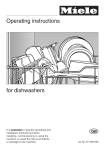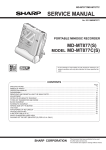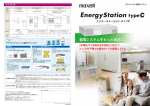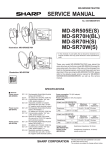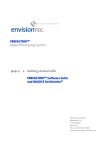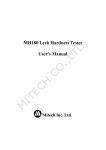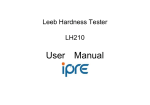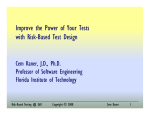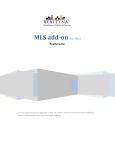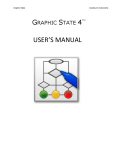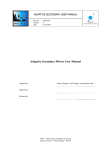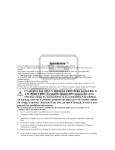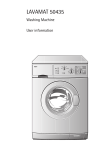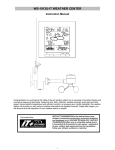Download PCE-2800 Leeb Hardness Tester User`s Manual
Transcript
www.pce-industrial-needs.com Tursdale Technical Services Ltd Unit N12B Tursdale Business Park Co. Durham DH6 5PG United Kingdom Phone: +44 ( 0 ) 191 377 3398 Fax: +44 ( 0 ) 191 377 3357 [email protected] http://www.industrial-needs.com/ PCE-2800 Leeb Hardness Tester User’s Manual [email protected] 1 Overview 3 1.1 Advantages 3 1.2 Main Application &Testing Range 3 1.2.1 Main Application 3 1.2.2 Testing Range 3 1.3 Technical Specifications 4 1.4 Configuration 5 1.5 Working Conditions 5 1.6 Safety Instructions 5 2 Structure Feature &Testing Principle 6 2.1 Structure Feature 6 2.1.1 The Hardness Tester Appearance 6 2.1.2 Parts of the Main body 6 2.1.3 D Type Impact Device 7 2.1.4 Different Types of Impact Device 2.2 Main Screen 7 2.3 Keypad Definitions 8 2.4 Leeb Hardness Testing Principle 9 3 Preparation 9 3.1 Instrument Preparation and Inspection 3.2 Impact Device Selection 9 3.3 Preparation of the Sample Surface 10 4 Testing Program 11 4.1 Start-Up 11 4.2 Loading 11 4.3 Localization 11 4.4 Testing 11 4.5 Read Measured Value 12 4.6 Notification 12 5 Operation Detail 13 5.1 Power On/Off 13 5.2 Material Setting 13 5.3 Hardness/Strength testing 14 5.4 Impact Direction Setting 14 5.5 Average Times Setting 14 5.6 Data logging 15 5.6.1 Viewing stored file/Group 15 5.6.2 Deleting selected file/Group 15 5.7 Print Function 15 5.8 System Reset 16 5.9 EL Backlight 16 5.10 Auto Power Off 16 5.11 Paper Installation 16 5.12 Battery Charge 16 1 7 9 [email protected] 5.13 Battery Replacement 17 5.14 Connecting to a Computer 17 5.15 Error Code Reference 17 6 Maintenance & Servicing 17 6.1 Impact Device Maintenance 17 6.2 Instrument Maintenance Program 18 6.3 Fault Analysis & Evacuation 18 6.4 Notice of Transport and Storage Conditions APPENDIX 19 Table 1 19 Table 2 20 Table 3 21 Table 4 22 2 18 [email protected] 1 Overview 1.1 Advantages z Wide measuring range. Based on the principle of Leeb hardness testing theory. It can measure the Leeb hardness of all metallic materials. z Large screen LCD, showing all functions and parameters. With EL background light. z Seven impact devices are available for special application. Automatically identify the type of impact devices. z Test at any angle, even upside down. z Direct display of hardness scales HRB, HRC, HV, HB, HS, HL. z Large memory could store 100 groups (Relative to average times 32~1 ) information including single measured value, mean value, impact direction, impact times, material and hardness scale etc. z Battery information showing the rest capacity of the battery and the charge status. z User calibration function. z Software to connect to PC via USB port. z Thermal printer integrated, convenient for in field printing. z NI-MH rechargeable battery as the power source. Charge circuit integrated inside the instrument. Continuous working period of no less than 150 hours (EL off and no printing). z Auto power off to save energy. z Outline dimensions:212mm×80mm×32mm 1.2 Main Application &Testing Range 1.2.1 Main Application z Die cavity of molds z Bearings and other parts z Failure analysis of pressure vessel, steam generator and other equipment z Heavy work piece z The installed machinery and permanently assembled parts z Testing surface of a small hollow space z Material identification in the warehouse of metallic materials z Rapid testing in large range and multi-measuring areas for large-scale work piece 1.2.2 Testing Range Testing range refer to Table 1 and Table 2 in the Appendix. 3 [email protected] 1.3 Technical Specifications z Error and repeatability of displayed value see Table1-1 below. Table 1-1 Type of impact Hardness value of Leeb Error of displayed No. device standard hardness block value z z z z z z z z z z Repeatability 1 D 760±30HLD 530±40HLD ±6 HLD ±10 HLD 6 HLD 10 HLD 2 DC 760±30HLDC 530±40HLDC ±6 HLDC ±10 HLDC 6 HLD 10 HLD 3 DL 878±30HLDL 736±40HLDL ±12 HLDL 12 HLDL 4 D+15 766±30HLD+15 544±40HLD+15 ±12 HLD+15 12 HLD+15 5 G 590±40HLG 500±40HLG ±12 HLG 12 HLG 6 E 725±30HLE 508±40HLE ±12 HLE 12 HLE 7 C 822±30HLC 590±40HLC ±12 HLC 12 HLC Measuring range:HLD(170~960)HLD Measuring direction:0°~360° Hardness Scale:HL、HB、HRB、HRC、HRA、HV、HS Display:segment LCD Data memory:100 groups max.(relative to impact times 32~1) Printing paper: width is 57.5±0.5 mm, diameter is 30mm. Battery pack: 6V NI-MH Battery charger: 9V/500mA Continuous working period about 150 hours With backlight off, no printing Communication interface USB1.1 4 [email protected] 1.4 Configuration Table 1-2 Standard Configuration Optional Configuration No. 1 2 3 4 5 6 7 8 9 11 Item Main unit D type impact device Standard test block Cleaning brush (I) Small support ring Battery Charger Paper for printing Manual Instrument package case Cleaning brush (II) Quantity 1 1 1 1 1 1 1 1 1 1 12 Other type of impact devices and support rings DataPro software Communication cable 1 1 13 14 15 16 Remarks With cable 9V 500mA For use with G type impact device Refer to Table 3 and Table 4 in the appendix. 1.5 Working Conditions Working temperature: -10 ~+50 ; Storage temperature:-30 ~+60 ; Relative humidity: ≤90%; The surrounding environment should avoid of vibration, strong magnetic field, corrosive medium and heavy dust. 1.6 Safety Instructions z The instrument can only work with the specially designed battery pack and power adapter (charger) supplied by Mitech Co. LTD. Working with others may result in damage of the instrument, battery leakage, fire or even explosion. z Do not cast the battery pack into fire and do not short circuit, disassemble or heat the battery pack, otherwise battery leakage, fire or even explosion may occur. Do not open the cover of the paper compartment or come into contact with the heating head of the printer by hand or any part of your body to avoid burns due to high temperature when the printer is printing. 5 [email protected] 2 Structure Feature &Testing Principle 2.1 Structure Feature 2.1.1 The Hardness Tester Appearance 1. Main unit 2. Impact device 2.1.2 Parts of the Main body 1 Socket of impact device 2 Socket of USB 3 LOGO 4 Paper compartment cover 5 LCD display 6 Keypad 7 Battery switch 8 Power jack 9 Serial Number 10 Product label 11 Battery compartment cover 6 [email protected] 2.1.3 D Type Impact Device 1 2 3 4 5 6 7 1 Release button 2 Loading tube 3 Guide tube 4 Coil unit 5 Connection cable 6 Impact body 7 Support ring 2.1.4 Different Types of Impact Device DC DL C D+15 E G 2.2 Main Screen Below is the main display screen: Average Icon Memory Icon Battery Info Hardness Scale Measured Value Impact Times Direction Instruction of the Main Display Screen: Material No 7 [email protected] Material:The present presetting material. Impact direction:The present impact direction. Hardness scale:Hardness scale of the present measured value. Battery information:Showing the rest capacity of the battery and the charging status. Measured value:Display present single time measured value(without showing average icon), or display the present mean value (with average icon prompting). “-HI-” means over conversion value or measure range. “-LO-” means lower than conversion value or measure range. Impact times: Times that have been impacted. Average Icon:It will appear when showing the mean value of the measured values after reaching the presetting impact times. Memory Icon: It appears when operating the instrument memory. 2.3 Keypad Definitions Table 2-1 Turn on/off the EL backlight Data Save or Data Delete Turn the instrument on/off Material Selection Hardness/Strength switch Plus or Up SCALE Hardness Scale Selection Direction change Minus or Down FEED Manual Paper Feed Impact Times set Print data Cancel or Exit Data logging or Enter Press key to store present group of measured value into memory. This operation is only valid after displaying the mean value. z z z z z z z Press key and could display single measured value. Press key could switch on of off the background light of LCD. Press key to set the impact direction. Press key to change the impact times in one group. The impact times item will flash when first pressing the key, and then the impact times value will plus or minus when pressing the or key. Press key finally to exit from changing the impact times process. SCALE Press key to change the hardness scale. Press key to change the material. Presetting hardness scale recovers to HL automatically after material presetting changed. Press key to switch between hardness test and strength test. Only D and DC type of impact device has the function of strength testing. So hardness testing is the only selection if the impact device is not D or DC type. 8 [email protected] z z Press Press FEED key to print out the measured values after measurement. key to manually feed the paper. 2.4 Leeb Hardness Testing Principle The basic principle is to use an impact body of certain weight impacts against the testing surface under certain test force, then measure the impacting velocity and the rebounding velocity of the impact body respectively when the spherically test tip is located 1mm above the testing surface. The calculation formula is as follows: HL=1000×VB/ VA Where, HL—— Leeb hardness value VB—— Rebounding velocity of the impact body VA—— Impacting velocity of the impact body 3 Preparation 3.1 Instrument Preparation and Inspection Verification of the instrument is by using standard test block. The error and repeatability of displayed value should be within the regulation of Appendix table 2. The instrument and impact device must be calibrated using a standard hardness block before use as the first time, or having not been used for a long time, or having reset the instrument system. Press key, meanwhile pressing down the key to power on the system. Then the user calibration screen shows as left below. Test for 5 points on the standard hardness block. It would display the average measured value key to after measuring 5 times. Press change to its nominal value. Press key to confirm the calibration finally. Or press the key to cancel the calibration. Range of adjustment: ±30HL. The measurement parameters, including the material setting, the hardness scale and the impact direction can’t be changed during calibration. Note:Use a calibrated hardness tester, test the standard test block downward vertically for 5 times, the arithmetical average value compare with the value of standard test block. If this value exceeds the standard value, could use the function of user calibration to adjust. 3.2 Impact Device Selection Refer to Appendix Table 1 and Table 3 for selection of impact device. 9 [email protected] 3.3 Preparaation of the Sample Surrface Preparaation for sam mple surfacce should coonform to th he relative requirement r t in Appendix Table 3. z In the preparationn processinng for sampple surface,, the hardness effect oof being heeated or coold processsing on the surface of sample s shouuld be avoid ded. z Too bigg roughnesss of the beinng measureed surface could c cause error. So, tthe surface of o the sampple to be measured m muust appear metallic m lustter, smoothiing and poliish, withoutt oil stain. z Supporrt of test sam mple. Suppport is no neecessary forr heavy sam mple. Mediuum-weight parts p must be set on the t smoothiing and stabble plane. The T sample must set abbsolutely eqquability and d without anny wobblee. z Curvedd surface: The T best tessting surfacce of samplle is flat. When W the cuurvature rad dius R of the t surfacee to be testeed is smaller than 30mm m (D, DC, D+15,C, E and DL typpe of impacct device) annd smallerr than 50mm m (G type of o impact device), d the small support ring or the shaped support rinngs should be chosen. z The sam mple shouldd have enouugh thicknesss, minimum m thicknesss of sample should confform to Tabble 3. z For thee sample with w hardeneed layer onn surface, th he depth off hardened llayer should conform to Table 3. 3 z z Coupling. Light-w weight sampple must bee firmly co oupled withh a heavy bbase plate. Both B couplled surfacee must be flat f and smoooth, and thhere is no redundant r c coupling ageent existing g. The impaact directioon must bee vertical too the coupleed surface. When the sample is a big platee, long rod or bendinng piece, it can c be defoormed and become b unsstable, evenn though itss weight and d thickness is big ennough, and accordinglyy, the test value may y not be accurate. a Soo the samp ple should be reinforrced or suppported at its back. Magneetism of the sample itseelf should bee avoided. 10 [email protected] 4 Testingg Program m 4.1 Start-Upp z Insert the t plug of the t impact device d into the socket of o impact deevice on thee instrumen nt. z Press thhe key,now powerr is on. The instrument is in workiing mode. 4.2 Loadingg Pushing the loading-tube downnwards untill contact is felt. f Then alllow it to slowly return n to the starting possition or usiing other meethod lockinng the impaact body. 4.3 Localizzation Press thee impact devvice supportting ring firrmly on the surface of the t sample, the impact direction should be vertical v to thhe testing suurface. 4.4 Testingg z Press the t release button on the t upside of the impaact device to t test. Thee sample an nd the impaact device as well as the operatoor are all reqquired to bee stable now w. The action direction n should paass the axis of the imppact device. m areea of the sam mple usuallly need 3 to o 5 times of o testing opperation. Th he result daata z Each measure disperssion should not more thhan mean vaalue±15HL.. z The disstance betw ween any tw wo impact pooints or from m the centeer of any im mpact point to t the edge of testing sample shoould conform m to the reggulation of Table T 4-1. z If wantt accurate conversion from f the Leeeb hardnesss value to other o hardneess value, co ontrastive teest is needded to get conversionn relations for the speecial materrial. Use innspection qu ualified Leeb hardness tester andd corresponnding hardnness tester to o test at the same sampple respectiv vely. For eaach hardness value, eaach measuree homogeneeously 5 po oints of Leebb hardness value in thee surroundinng of morre than threee indentatioons which need n converrsion hardneess, using L Leeb hardneess arithmettic averagee value andd corresponnding hardneess averagee value as correlative c vvalue respectively, maake individdual hardness contrastiive curve. Contrastive C e curve at least shouldd include th hree group of correlaative data. 11 [email protected] Table 4-1 Type of Impact Device Distance of center of the two indentations Distance of center of the indentation to sample edge Not less than (mm) Not less than (mm) D、DC 3 5 DL 3 5 D+15 3 5 G 4 8 E 3 5 C 2 4 4.5 Read Measured Value After each impact operation, the LCD will display the current measured value, impact times plus one, the buzzer would alert a long howl if the measured value is not within the valid range. When reaching the presetting impact times, the buzzer will alert a long howl. After 2 seconds, the buzzer will alert a short howl, and display the mean measured value. 4.6 Notification z Replacing the impact device must be done during Power off. Otherwise the main body could not identify the type of the impact device, and it may damage the circuit board of the main body. z You could not save the current test value if the impact time is less than the presetting times value. z Only type D and type DC of impact device have the function of strength test option. You can not change the setting to strength testing when using other types of impact device. The setting would be set to hardness testing automatically after replacing the impact device whether the setting is hardness testing or not before. Not all materials could convert to all hardness scale value. The hardness scale is reset to HL automatically after changing the material. So select material firstly before changing the hardness scale. 12 [email protected] 5 Operation Detail 5.1 Power On/Off Press to power on the instrument. Be sure to plug in the impact device before powering on. The system would automatically detect the type of the impact device during power up, and would display this information on the screen. Users should pay attention to the probe type displayed on the screen. After pausing for several second, the screen will exit and enter the main display screen as following: The instrument can be turned off by pressing the key while it is working. The tool has a special memory that retains all of its settings even when the power is off. Note: If the instrument is in power off condition, it will turns on automatically after the charge power is connected. 5.2 Material Setting Press key to change the material to the one you want to preset. Hardness scale recovers to HL automatically after material presetting changed. Please select material firstly, then select hardness scale. In hardness testing, you can select the material among the following materials: Steel and Cast Steel、Cold Work Tool Steel、Stainless Steel、Gray Cast Iron、Nodular Cast Iron、Cast Aluminum Alloys、Copper-Zinc Alloys、Copper-Aluminum Alloys、Wrought Copper and Wrought Steel. The relationship between the material number displayed on the instrument screen and the material is as follows: Table 5-1 Material No. Material Material No. Material 0 Steel and cast steel 5 Cast aluminum alloys 1 Cold work tool steel 6 Copper-Zinc alloys 2 Stainless steel 7 Copper –Aluminum alloys 3 Gray cast iron 8 Wrought copper 4 Nodular cast iron 9 Wrought steel 13 [email protected] In strength testing, the following materials are selectable: Mild Steel、High-Carbon Steel、Cr Steel、Cr-V Steel、Cr-Ni Steel、Cr-Mo Steel、Cr-Ni-Mo Steel、Cr-Mn-Si Steel、Super Strength Steel and Stainless Steel. The relationship between the material number displayed on the instrument screen and the material is as follows: Table 5-2 Material No Material Material No Material 0 Mild steel 5 Cr-Mo steel 1 High carbon steel 6 Cr-Ni-Mo steel 2 Cr steel 7 Cr-Mn-Si steel 3 Cr-V steel 8 Super strength steel 4 Cr-Ni steel 9 Stainless steel 5.3 Hardness/Strength testing Press key to switch between hardness testing and strength testing (бb) . Note: Only D and DC type of impact device has the function of strength testing. So hardness testing is the only selection if the impact device is not D or DC type. SCALE In hardness testing, Press key to change the hardness scale. The supported hardness scale includes: HL, HV, HB, HRC, HS, HRB and HRA. Note: z Here only displays the valid hardness scale for the present selected impact device and material. It would not display the hardness scale which is not valid. z Please select material firstly, then select hardness scale. z Presetting hardness scale recovers to HL automatically after presetting material is changed. 5.4 Impact Direction Setting Press the key to move to the impact direction that you will preset. 5.5 Average Times Setting You could modify average times within the range of 1 to 32 as following: 1) Press key in testing state. The impact times item will begin to flash. 2) Press or key to set the average times to the number you want. Press key finally to exit from the operation. 14 [email protected] 5.6 Data logging At most one hundred files (F00-F99, one group as one file) can be stored inside the gauge. By simply pressing the key after a new measurement finishes-the screen showing the “AVE” icon, the measured hardness/strength group values will be saved to memory. The new saved file is appended as the last file of the memory. This function provides the user with the ability to view/delete a file/group previously saved in memory. 5.6.1 Viewing stored file/Group To view the memory data, follow the steps: 1) Press the key to activate the data logging function. The memory icon will appear. It will display the current file name, the test parameter of the group data and the mean value of the group. If there is no data in the memory, it will display: <E04>, which means no memory data, and then return back. 2) Use the key and the key to select the desired file to view. 3) Press the key to see details of that group data. 4) Use the key and the key to view each single measured data in that group while viewing details. 5) Press the key to return to previous screen at any time during data logging. 5.6.2 Deleting selected file/Group The user may require deleting a file from the instrument memory. The procedure is outlined in the following steps. 1) Press the key to activate the data logging function. The memory icon will appear. It will display the current file name, the test parameter of the group data and the mean value of the group. If there is no data in the memory, it will display: <E04>, which means no memory data, and then return back. key and the key to scroll to the file that will be deleted. 2) Use the 3) Press the key on the desired file. It will automatically delete the file, and display “-DEL”. 4) Press the key, at any time, to exit the data logging function and return to measurement mode. Note: Do not shut down the instrument while deleting data. It could lead to unpredicted consequence if shutting down while deleting. 5.7 Print Function At the end of the inspection process, or end of the day, the user may require the readings be printed. You can print out the measurement result immediately after each testing process, by easily pressing the key. If you want to print the data stored in the instrument memory, then following is the steps: 1. Press the key to activate the data logging function. The memory icon will appear. 2. Use the key and the key to select the desired file. 3. Press the key to print the selected file. This operation will print out all the data in current file. 4. Press the key to exit the data logging functions and return to measurement mode. Note: z Printing function is unavailable while charging. z Printing can be stopped by pressing the key. z Do not open the cover of the paper compartment during printing. Otherwise the instrument may not print normally. z Over high ambient humidity (above 85% of relative humidity) or over low ambient humidity (below 20% of relative humidity) may reduce the print quality. z Printing with paper that has been stored for over long period of time or of poor quality may 15 [email protected] reduce the print quality or even damage the printer. When the printer is powered on and ready for printing, press key then the instrument will start key to start paper feeding, while releasing the manual paper feeding. Press and keep holding the key to stop paper feeding. Note: Manual paper feeding is unavailable while charging. FEED FEED 5.8 System Reset SCALE Press down the key while powering on the instrument will restore factory defaults. The only time this might possibly helpful is if the parameter in the instrument was somehow corrupted. 5.9 EL Backlight With the EL background light, it is convenient to work in the dark condition. Press key to switch on or switch off the background light at any moment as you need after power on. Since the EL light will consume much power, turn on it only when necessary. 5.10 Auto Power Off The instrument features an auto power off function designed to conserve battery life. If the tool is idle (neither measuring nor any key operation) for 5 minutes, it will turn itself off. Before powering off, the LCD display of the instrument will continue flashing for 20 seconds. Except key , press any key could stop the twinkle of LCD screen and stop the operation of power off at the moment. While the voltage of the battery is too low, the display will show <E00>, then power off automatically. When the instrument is being charged, the Auto Power Off will not function. 5.11 Paper Installation z Hold Both ends of the paper compartment with fingers and open the compartment cover with moderate strength. z According to the illustration, put the paper into the paper compartment with attention to the paper direction. If the paper is misplaced, the instrument will fail to print. z Pull a trip of paper out of the compartment. z Make sure that the paper is well in place and close the paper compartment cover. 5.12 Battery Charge The instrument uses a NI-MH battery pack as its power source. When the battery pack almost runs out, the battery symbol on the display will glint . It needs charging as soon as possible. Try to drain your battery pack as fully as possible before it is charged for longest battery service. 16 [email protected] z z z z The battery switch should be at ‘ON’ condition before charging. Plug the power adapter into the mains supply power socket and then plug the charger connector into the power jack of the instrument. If the instrument is in power off condition, it will turns on automatically after the charger plug is inserted into the power jack. The battery symbol will alternately shows between and when charging. The more of the dark part indicates the more close to full capacity. When the battery is fully charged, the battery symbol on the display will glint . Please use the configured AC-DC adapter to charge the battery pack. Warning: When the battery pack is being charged, printing or paper feeding is unavailable. 5.13 Battery Replacement When the battery pack fails to be charged, the user should replace the batteries following the program below: z Power down the instrument. z Take off the battery compartment cover and take out the battery pack. z Insert the connection plug of the new battery pack into the socket on the circuit board. z Reset the battery cover. z Turn on the instrument to check. Warning: Please pay much attention to the polarity of the battery during battery replacement. 5.14 Connecting to a Computer Insert one connection plug of the transmission cable into the USB socket on the right side of main body, and insert the another plug into the USB port on the back of computer box. Refer to the manual of the DataPro software for detailed information. 5.15 Error Code Reference Error Code Explanation E00 Battery exhausted E01 Value out of range E02 Measurement not finished E03 Data already saved E04 No memory data Error Code E05 E06 E07 E08 E09 Explanation Can not print Battery Charging No paper for printing Over Temperature 6 Maintenance & Servicing 6.1 Impact Device Maintenance z After the impact device has been used for 1000--2000 times, please use the nylon brush provided to clean the guide tube and impact body. When cleaning the guide tube, unscrew the support ring first, then take out the impact body, spiral the nylon brush in counter-clock direction into the bottom of guide tube and take it out for 5 times, and then install the impact body and support ring again. z Release the impact body after use. z Any lubricant is absolutely prohibited inside the impact device. 17 [email protected] 6.2 Instrument Maintenance Program z When using standard Rockwell hardness block to testing, if all the error is bigger than 2 HRC, it may be the invalidation of impacted ball top caused by abrasion. Changing the spherical test tip or impact object should be considered. z When the hardness tester appears some other abnormal phenomena, please do not dismantle or adjust any fixedly assembled parts. Fill in and present the warranty card to us. The warranty service can be carried on. 6.3 Fault Analysis & Evacuation Fault Appearance Fault Analysis Battery failure Charge failure No measured value Failure power on The battery is switched off Impact device cable failure Battery exhaustion The battery is switched off Handling method Replace the battery with a new pack Switch on the battery Replace the cable Charge the battery Switch on the battery 6.4 Notice of Transport and Storage Conditions z Keep it away from vibration, strong magnetic field, corrosive medium, dumpiness and dust. Storage in ordinary temperature. z With original packing, transport is allowed on the third grade highway. 18 [email protected] APPENDIX Table 1 Material Method HRC HRB Steel and cast steel HRA HB HV HS Cold work tool steel Stainless steel HRC HV HRB Grey cast iron HB HV HRC HB HV HRC Nodular cast iron HB Cast aluminum alloys BRASS(copperzinc alloys) BRONZE(copp er-aluminum/tin alloys) Wrought copper alloys HV HB HRB HB HRB Impact device D/DC D+15 C G 19.3 67 20.0 69 20 68.5 .9 .5 38.4 99 47.7 99. .6 9 59.1 85 .8 127 65 80 638 80 683 90 646 1 83 976 80 937 80 996 32.2 99 33.3 99 31.8 10 .3 2.1 .5 20.4 67 19.8 68 20.7 68 .1 .2 .2 100 94 80 898 80 935 1 46.5 10 1.7 85 655 85 802 93 334 92 326 131 38 7 127 364 19 164 23.8 84 .6 40 173 13.5 95 .3 HB 60 290 HB 45 315 E 22.4 70.7 DL 20.6 68 .2 37.0 99 .9 61.7 88.0 83 663 81 646 84 1042 35.8 102. 6 80 950 30.6 96 .8 22.6 70.2 82 1009 23 210 32 168 22.7 85 23.8 85. .0 5 19 [email protected] Table 2 No. Material HLD Strength σb(MPa) 1 Mild steel 350 522 374 780 2 High-Carbon steel 500 710 737 1670 3 Cr steel 500 730 707 1829 4 Cr-V steel 500 750 704 1980 5 Cr-Ni steel 500 750 763 2007 6 Cr-Mo steel 500 738 721 1875 7 Cr-Ni-Mo steel 540 738 844 1933 8 Cr-Mn-Si steel 500 750 755 1993 9 Super strength steel 630 800 1180 2652 10 Stainless steel 500 710 703 1676 20 [email protected] Table 3 Type of impact device DC(D)/D L Impacting energy 11mJ Mass of impact body 5.5g/7.2g Test tip hardness: 1600HV Dia. Test tip: 3mm Material of test tip: Tungsten carbide Impact device diameter: 20mm Impact device length: 86(147)/ Impact device weight: 75mm 50g Max. hardness of sample 940HV Mean roughness value 1.6μm of sample surface Ra: Min. weight of sample: Measure directly Need support firmly Need coupling tightly Min. thickness of sample Coupling tightly Min. layer thickness for surface hardening Size of tip indentation Hardness Indentation 300HV diameter Depth of indentation Hardness Indentation 600HV diameter Depth of indentation Hardness 800HV Indentation diameter Depth of indentation Available type of impact device D+15 C G E 11mJ 7.8g 1600HV 3mm Tungsten carbide 20mm 162mm 80g 2.7mJ 3.0g 1600HV 3mm Tungsten carbide 20mm 141mm 75g 90mJ 20.0g 1600HV 5mm Tungsten carbide 30mm 254mm 250g 11mJ 5.5g 5000HV 3mm synthetic diamond 20mm 155mm 80g 940HV 1.6μm 1000HV 0.4μm 650HB 6.3μm 1200HV 1.6μm >5kg 2 5kg 0.05 2kg >5kg 2 5kg 0.05 2kg >1.5kg 0.5 1.5kg 0.02 0.5kg >15kg 5 15kg 0.5 5kg >5kg 2 5kg 0.05 2kg 5mm 5mm 1mm 10mm 5mm ≥0.8mm ≥0.8mm ≥0.2mm ≥1.2mm ≥0.8mm 0.54mm 0.54mm 0.38mm 1.03mm 0.54mm 24μm 24μm 12μm 53μm 24μm 0.54mm 0.54mm 0.32mm 0.90mm 0.54mm 17μm 17μm 8μm 41μm 17μm 0.35mm 0.35mm 0.35mm -- 0.35mm 10μm 10μm 7μm -- 10μm DC: Test hole or hollow cylindrical; DL:Testslen der narrow groove or hole D+15: Test groove or reentra nt surfac e C: Test small,light, thin parts and surface of hardened layer G: Test large, thick,heav y and rough surface steel E: Test super high hardness material 21 [email protected] Table 4 N No. Tyype Sketch of non- Remarrks convenntional Supportting ring 1 Z10-15 For teesting cylindrical outside surface R10 R15 2 Z144.5-30 For teesting cylindrical outside s surface R144.5 R30 3 Z25-50 For teesting cylindrical outside surface R225 R50 4 HZ111-13 For testing t cylinndrical insid de surface R11 R13 5 HZ12.5-17 For testing t cylinndrical insid de s surface R122.5 R17 6 HZ16.5-30 For testing t cylinndrical insid de s surface R166.5 R30 7 K10-15 For testing t spheerical outsid de s surface SR10 SR15 8 K144.5-30 For testing t spheerical outsid de suurface SR144.5 SR30 9 HK11-13 For testing spheerical insidee s surface SR11 SR13 1 10 HK12.5-17 For testing spheerical insidee suurface SR122.5 SR17 1 11 HK16.5-30 For testing spheerical insidee suurface SR166.5 SR30 1 12 U UN For teesting cylindrical outside surfacee,radius adjuustable R10 0 ∞ In this direction will find a vision of the measurrement techniqu ue: ustrial-needs.com m/measuring-in nstruments.htm http://www.indu e ATEX prote ection, so it should s not be used in po otentially explosive NOTE: "Thiss instrument doesn’t have atmospheress (powder, flammable ga ases)." 2 22

























